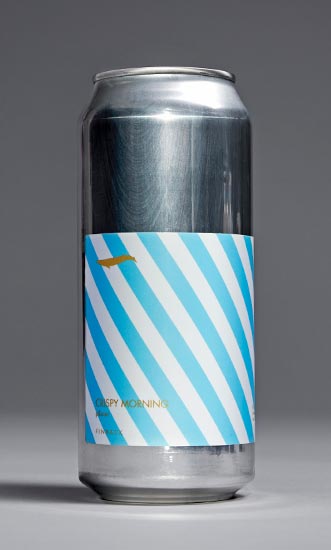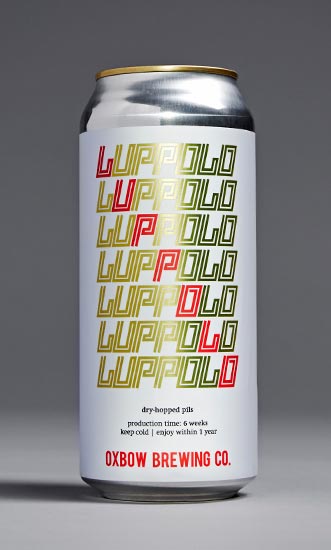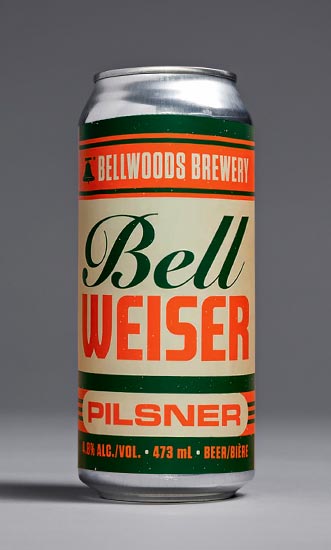Within the early days of craft beer, bottles and cans appeared to all be saying, or perhaps screaming, the identical factor: Drink me in case you dare. Breweries relied on intense imagery to telegraph an air of exclusivity. Take into account Stone Brewing, fashioned in California in 1996, whose labels heart gargoyles in a wide range of aggressive poses, and whose choices embrace Stone IPA, an influential beer of the model. Or, see Indiana’s 3 Floyds Brewing, based the identical 12 months, which took a much less medieval, extra steel strategy to its visible id. The bottle of its cult basic Zombie Mud, an American pale ale first launched in 2010, options art work of the undead by comedian e book artist Tim Seeley, who typically dabbles in horror.
Heady Topper, first canned in 2011 by The Alchemist brewery in Vermont, represented the beginning of a shift. Designed by Dan Blakeslee, an artist and musician who got here to beer labels by the use of live performance posters, the now-iconic can includes a bearded, bow-tied man sipping a glass of beer—breaking the brewery’s cardinal rule to drink from the can—as a cloud of hops explodes out of the highest of his head. It’s monochromatic. It’s assured. It appears extra desirous about evoking its personal world than in referencing tropes from one other. With its shaded traces and heavy serif lettering, it extra intently resembles an Artwork Nouveau etching than an Iron Maiden album cowl from the Nineties, nevertheless it continued the custom of florid, illustrative labels.
If the rise of craft beer got here from a longing for extra depth of taste, then the advertising of those drinks wanted to be extra visually wealthy than that of their company opponents. There was a necessity to tell apart craft beer from, you already know, common beer. Because of this, IPA labels are inclined to learn as a provocation: Are you able to deal with this a lot hoppiness? And, for a very long time, most IPAs in the US have been homebrewed, poured instantly from growler or faucet to glass, so packaging design merely didn’t exist, or was not meant for large distribution. As soon as bona fide IPA manufacturers began to emerge within the ’90s, their visible id was formed not by a protracted custom, however by a really specific pressure of masculinity and one-upmanship that was attribute of the beer tradition on the time.
As American craft beers have expanded past the IPAs of the ’90s and early 2000s, the look of the trade as a complete has typically develop into much less over-the-top. On in the present day’s craft beer cabinets, there are fewer representational motifs, and extra fashionable, modular graphics. More and more standard craft pilsners, with their lighter, clearer taste and relatively minimal branding, are a very good instance of the shift to market craft beer to a wider viewers, they usually’ve develop into the defining model of the aesthetic. “There’s no explosions or dinosaurs on the skin of pilsner cans,” says Cory Muscato, co-owner of The Beer Hold, a craft beer bar and store in Buffalo, New York, which shares some 250 SKUs. “I’d describe the labels for IPAs as like a Michael Bay film,” he says. “Pilsners are somewhat bit extra classical.”
Listed below are 5 pilsner cans that supply a take a look at the brand new face of craft beer.
 Designers Max Kaplun and Audrey Robinson have been buddies with Dan Suarez and Taylor Cocalis since their days in Brooklyn, after they’d hang around at Beer Desk in South Slope. Right this moment, Kaplun and Robinson are based mostly in Montreal, and Suarez and Cocalis are in New York’s Hudson Valley, the place they run their eponymous brewery. “We at all times love working with Max and Audrey expressly as a result of there may be such a human component—very similar to with the beer,” says Cocalis. For the Palatine Pils, one of many first label tasks the pair labored on, that human component got here from analog inspiration. “We arrived on the search for these specific labels by digging up some classic French kind specimen books that actually had this funky look you simply couldn’t obtain with a digital font,” says Kaplun. (Sort specimen books are precisely what they sound like, basically discipline guides for fonts.) Reference in hand, the designers took to the display to create the Palatine Pils label from scratch, which, with its ribbony lettering and outsized dots over the i’s, seems prefer it could possibly be the signal for a really refined Nineteen Fifties bowling alley. It’s without delay textured and refined, or, to place it in Cocalis’ phrases, “basic, but contemporary.”
Designers Max Kaplun and Audrey Robinson have been buddies with Dan Suarez and Taylor Cocalis since their days in Brooklyn, after they’d hang around at Beer Desk in South Slope. Right this moment, Kaplun and Robinson are based mostly in Montreal, and Suarez and Cocalis are in New York’s Hudson Valley, the place they run their eponymous brewery. “We at all times love working with Max and Audrey expressly as a result of there may be such a human component—very similar to with the beer,” says Cocalis. For the Palatine Pils, one of many first label tasks the pair labored on, that human component got here from analog inspiration. “We arrived on the search for these specific labels by digging up some classic French kind specimen books that actually had this funky look you simply couldn’t obtain with a digital font,” says Kaplun. (Sort specimen books are precisely what they sound like, basically discipline guides for fonts.) Reference in hand, the designers took to the display to create the Palatine Pils label from scratch, which, with its ribbony lettering and outsized dots over the i’s, seems prefer it could possibly be the signal for a really refined Nineteen Fifties bowling alley. It’s without delay textured and refined, or, to place it in Cocalis’ phrases, “basic, but contemporary.”
 “Our basic strategy is to create designs which might be easy and graphic,” says Basil Lee, co-owner of Finback Brewery in Queens. Finback’s label design has at all times been carried out in-house, and as of late, Lee’s companion Kevin Stafford handles that facet of the enterprise. For Crispy Morning, the model’s core pilsner, the purpose was to create one thing iconic and versatile. (The model has additionally brewed some variants, like Crispy City, and altered the colour of the traces.) Crispy Morning’s sky-blue diagonal stripes recall paper straws from the Eisenhower period, hinting on the imminent refreshment that lies contained in the can. They’re additionally a departure from the model’s sometimes extra dreamy, bizarre designs. Although the expressions are various, Finback’s 16-ounce cans are recognizable on a shelf as a result of the labels—every of which comprises a fin-shaped mark on the upper-left nook—cowl solely two-thirds of the floor, exposing a lot of the shiny steel. That constant, shrunken sizing permits for many selection throughout labels, whereas nonetheless showing unified.
“Our basic strategy is to create designs which might be easy and graphic,” says Basil Lee, co-owner of Finback Brewery in Queens. Finback’s label design has at all times been carried out in-house, and as of late, Lee’s companion Kevin Stafford handles that facet of the enterprise. For Crispy Morning, the model’s core pilsner, the purpose was to create one thing iconic and versatile. (The model has additionally brewed some variants, like Crispy City, and altered the colour of the traces.) Crispy Morning’s sky-blue diagonal stripes recall paper straws from the Eisenhower period, hinting on the imminent refreshment that lies contained in the can. They’re additionally a departure from the model’s sometimes extra dreamy, bizarre designs. Although the expressions are various, Finback’s 16-ounce cans are recognizable on a shelf as a result of the labels—every of which comprises a fin-shaped mark on the upper-left nook—cowl solely two-thirds of the floor, exposing a lot of the shiny steel. That constant, shrunken sizing permits for many selection throughout labels, whereas nonetheless showing unified.
 “I sort of appreciated taking part in on the thought of not being blind drunk,” says John Gilsenan of London-based branding company IWANT, who based mostly the Talea design across the shapes present in his assortment of classic optometrist lightboxes, the type used for eye exams. When Gilsenan was engaged on the can for Al Dente, the corporate’s Italian-style pilsner, he knew that he wanted to “strip the design again somewhat,” greater than he would for a seasonal, small-batch providing, as a result of it wanted to have the ability to develop with the model. The result’s spare however placing: two stacked dots, one a muted San Marzano pink, the opposite a Mediterranean blue or sage inexperienced, relying on the can. Talea’s elemental strategy to packaging design displays the enterprise mannequin of recent craft breweries, a lot of which produce various beers per 12 months. Although Talea’s visible language continues to evolve with its expanded choices, these unique optical-inspired parts nonetheless inform the general id.
“I sort of appreciated taking part in on the thought of not being blind drunk,” says John Gilsenan of London-based branding company IWANT, who based mostly the Talea design across the shapes present in his assortment of classic optometrist lightboxes, the type used for eye exams. When Gilsenan was engaged on the can for Al Dente, the corporate’s Italian-style pilsner, he knew that he wanted to “strip the design again somewhat,” greater than he would for a seasonal, small-batch providing, as a result of it wanted to have the ability to develop with the model. The result’s spare however placing: two stacked dots, one a muted San Marzano pink, the opposite a Mediterranean blue or sage inexperienced, relying on the can. Talea’s elemental strategy to packaging design displays the enterprise mannequin of recent craft breweries, a lot of which produce various beers per 12 months. Although Talea’s visible language continues to evolve with its expanded choices, these unique optical-inspired parts nonetheless inform the general id.
 For Will Sears, the artwork director at Portland, Maine’s Oxbow, the purpose with the packaging design for Luppolo was to have a good time the tradition it got here from. The brew kind, a dry-hopped Italian-style pilsner, directed Sears to midcentury European graphics and in the end led to “outdated Italian bicycle stuff,” which exhibits up within the horizontal repetition of a sporty however suave squared-off kind, together with a diagonal of the beer’s identify in pink. The design has a fast, quiet sense of movement. Sears sketches in notebooks “continually,” and each Oxbow design begins as a hand drawing that then will get scanned in and vectorized. He likes the “freedom by means of restriction” that comes from the model’s tight design system, which features a colour palette consisting of simply three colours: mild blue, pink and black (plus gold, however just for lagers). Illustrations are restricted and infrequently integrated into the lettering. However the streamlining of label design isn’t nearly aesthetics—it’s good enterprise, too, as a restricted graphic system is less complicated to scale than a single illustration model.
For Will Sears, the artwork director at Portland, Maine’s Oxbow, the purpose with the packaging design for Luppolo was to have a good time the tradition it got here from. The brew kind, a dry-hopped Italian-style pilsner, directed Sears to midcentury European graphics and in the end led to “outdated Italian bicycle stuff,” which exhibits up within the horizontal repetition of a sporty however suave squared-off kind, together with a diagonal of the beer’s identify in pink. The design has a fast, quiet sense of movement. Sears sketches in notebooks “continually,” and each Oxbow design begins as a hand drawing that then will get scanned in and vectorized. He likes the “freedom by means of restriction” that comes from the model’s tight design system, which features a colour palette consisting of simply three colours: mild blue, pink and black (plus gold, however just for lagers). Illustrations are restricted and infrequently integrated into the lettering. However the streamlining of label design isn’t nearly aesthetics—it’s good enterprise, too, as a restricted graphic system is less complicated to scale than a single illustration model.
 “Bellweiser was impressed by the basic Canadian stubby bottles our dad and mom and grandparents drank after we have been rising up,” says Ross Proulx, of Toronto-based design and illustration studio Doublenaut, who cites Labatt, Outdated Vienna and Purple Cap’s “sturdy use of typography and daring supporting graphics” as influences. Earlier than Bellweiser’s launch, Bellwoods Brewery (additionally in Toronto) was recognized for its IPAs and bitter beers, which have been marked by a largely illustrative packaging design model. In an effort to tell apart Bellwoods’ first pilsner and the road that may observe, Doublenaut shifted to utilizing kind as the first component of the design, contrasting with easy shapes. However the design retains issues fascinating by juxtaposing a wide range of sorts, stacked proper on prime of each other. To attain at-a-glance legibility with out having to make the sort smaller, the identify is break up, and the fonts differentiated—“Bell” in a strong cursive, and “Weiser” in a chunky, approachable sans serif. In a approach, Bellwoods’ and Doublenaut’s foray from IPAs into pilsners matches the arc of the face of the trade total—from dank, doodly and doing-the-most to crisp, clear and contained.
“Bellweiser was impressed by the basic Canadian stubby bottles our dad and mom and grandparents drank after we have been rising up,” says Ross Proulx, of Toronto-based design and illustration studio Doublenaut, who cites Labatt, Outdated Vienna and Purple Cap’s “sturdy use of typography and daring supporting graphics” as influences. Earlier than Bellweiser’s launch, Bellwoods Brewery (additionally in Toronto) was recognized for its IPAs and bitter beers, which have been marked by a largely illustrative packaging design model. In an effort to tell apart Bellwoods’ first pilsner and the road that may observe, Doublenaut shifted to utilizing kind as the first component of the design, contrasting with easy shapes. However the design retains issues fascinating by juxtaposing a wide range of sorts, stacked proper on prime of each other. To attain at-a-glance legibility with out having to make the sort smaller, the identify is break up, and the fonts differentiated—“Bell” in a strong cursive, and “Weiser” in a chunky, approachable sans serif. In a approach, Bellwoods’ and Doublenaut’s foray from IPAs into pilsners matches the arc of the face of the trade total—from dank, doodly and doing-the-most to crisp, clear and contained.










